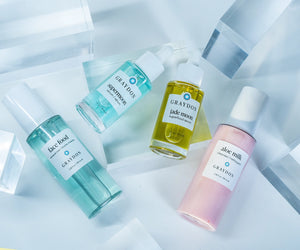It’s well known at this point that some kind of prep is important before applying your makeup. It also just makes sense in the morning–you start with your skincare routine, then move on to makeup if you wear it. So I’d bet most of you use some skincare before any makeup goes on your skin. However, there can be tons of snags you encounter when you mix makeup and skincare.
I’m mostly talking about your skincare causing problems with your foundation, but this also applies to other cream and liquid makeup like cream blushes and contour or liquid highlighters and eyeshadows. Sometimes your skincare prep (whether you’re using the wrong products or the wrong techniques) causes your makeup to go on patchy or cakey. You might also find your foundation separates or pills.
Let’s go through all the reasons why your skincare prep might be causing problems with your makeup. It could be anything from using incompatible formulas to not waiting long enough for your skincare to absorb.
5 Reasons Why Your Skincare Prep Isn’t Helping Your Makeup

I just mentioned incompatible formulas. That’s because some skincare is oil-based, and others are water-based.
Before we start, here are two of our serums. I want you to guess which one is water-based and which one is oil-based.
The answer will be revealed at the end of the article!
Your skincare’s formula is incompatible with your foundation’s formula
You’ve probably heard metaphors about trying to mix oil and water hundreds of times. It’s a piece of knowledge we all know and have heard time and time again–and it’s especially true when it comes to the skincare and makeup products you put on your face.
Most skincare products will be either water-based or oil-based, and are occasionally silicone-based. The rule of thumb is pretty easy to remember: oil-based skincare goes well with oil-based makeup, water-based skincare goes well with water-based makeup, and silicone-based skincare goes well with silicone-based makeup.
There are a couple of combinations that work well, too. Water-based or oil-based skincare and silicone makeup tend to pair up just fine, but silicone-based skincare (or primer) with a water or oil-based foundation over top will cause separation or pilling.
Any other combinations will probably result in a patchy makeup application. But it’s always smart to test your products to see if they’re the exception.
Products with the same base pair well together and won’t cause separation or pilling.
Here’s how: Apply your skincare to the back of your hand, then layer your foundation over top (sandwich your primer in between if you use it). If you see any separation, they aren’t compatible.
If you really love both your skincare products and your makeup products and are reluctant to switch even though you’re having problems–try waiting longer than usual between applying your skincare and applying your makeup. That extra time to absorb so your skin is dry to the touch when you apply your makeup can help (but might always work as a solution).
You put on too much skincare product or haven’t waited long enough to let it absorb
When you put on too much product, your skin can’t absorb it all. Just like a sponge or paper towel, your skin can only hold so much before it’s “full.” That means some product is still sitting on the surface of your skin, leaving it feeling slippery to the touch. You might also not have given the product enough time to absorb fully into the skin, even if you’ve put on the right amount.
Either way, the residue still on the skin means that your foundation or primer doesn’t have somewhere it can stick to. Instead, primer and/or foundation can slip around and mix with the residue, leading to uneven coverage.
How do you know when your skin is ready? When you touch your skin, it should feel tacky. This lets you know your skincare is absorbed enough to start on makeup.
Your skin is ready for makeup after your skincare prep when it feels tacky to the touch.
If this is happening to you all the time, try applying less of each skincare product during your prep process.
If you’ve accidentally applied too much anyway, try sweeping a dry cotton pad over your skin to remove excess product. You can also wait longer than usual in the hopes that any excess product will absorb after more time.
You didn’t exfoliate
Uneven skin leads to an uneven foundation application. Why? Foundation often clings to any texture or dead skill cells and accentuates them.

Plus, when a mix of makeup and built-up dead skin cells sit on your skin, it can cause congestion.
The solution is to exfoliate before makeup! Since exfoliation is such a broad skincare category, you have tons of options for this step. You can manually exfoliate with an exfoliation tool like a sponge, use a scrub with exfoliating pieces in it, or choose a cleanser containing exfoliating acids.
We offer a couple of options for exfoliation. Our foaming cleanser, Face Foam, gently exfoliates using azelaic acid and natural BHAs. Our bamboo charcoal sponge is a fan favourite for gentle exfoliation, and is great when your skin is sensitive and doesn’t want a separate cleanser and exfoliator–using the sponge while cleansing lets you do double duty.
You didn’t moisturize
Just like dead skin cells that need to be exfoliated away, dry skin often has texture that foundation can cling to. That’s why it’s important to moisturize before applying foundation or primer, because it helps smooth out your skin by hydrating it, especially your dry patches.
If you have oily skin, you might not need an intense moisturizer, but some kind of hydration is still important–a gel moisturizer like Phyto Clear, a few drops of a hydrating serum like Supermoon, or even a hydrating toner like Face Food could do the trick. (Just as long as you don’t leave your skin parched enough that it ups its sebum production).
Hydrated skin is plump and provides a smoother base for your makeup.
For those who do deal with dryness, your go-to moisturizer is exactly what you need to prep your skin for makeup, plus whatever hydrating serum you use (as long as you follow the oil/water/silicone rule from earlier in this article!).
You didn’t prep based on your skin type
Oily, dry, mature, and combination skin all need different approaches when you’re prepping for makeup.

Alongside these skin types, it’s also important to spot treat any areas that need your attention. For example, even a dry patch on your normally oily skin needs a thicker moisturizer or an oil serum to hydrate it.
Paying attention to the areas where your makeup seems to wear off, cake up, or smudge throughout the day helps you zero in on where you might need some extra skincare support or a switch-up to your regular routine. I know some people with combination skin who treat their t-zone entirely differently than the rest of their face. With mature skin, products that plump skin help create a nice base for makeup and can help stop makeup from settling into fine lines.
It all comes down to understanding your skin and what it needs. It might sound cheesy, but getting in touch with your skin and paying attention to how it responds to different products, environments, and routines helps you know how to care for your skin in any situation–including prepping it for makeup.
Up Your Skin Prep Game

Now that you know some reasons why your skincare prep isn’t working, you can harmonize your skincare + makeup so that your face card never gets declined 💅
We also have the answer to our little pop quiz from earlier! Did you get it right?
If you're not sure what products will work for you, let us help you out.
We put together a skin quiz that gives you individualized product recommendations based on your results. Plus, we give a little gift to people who complete it 😉



